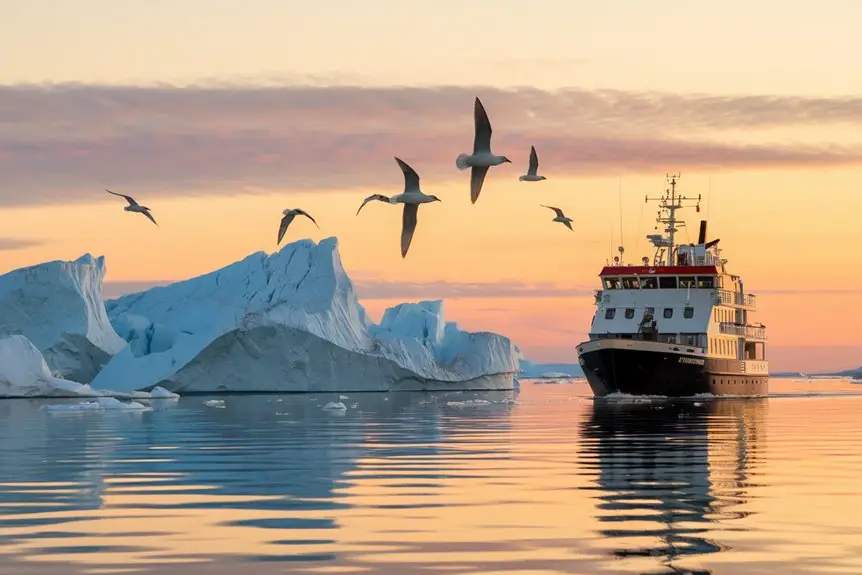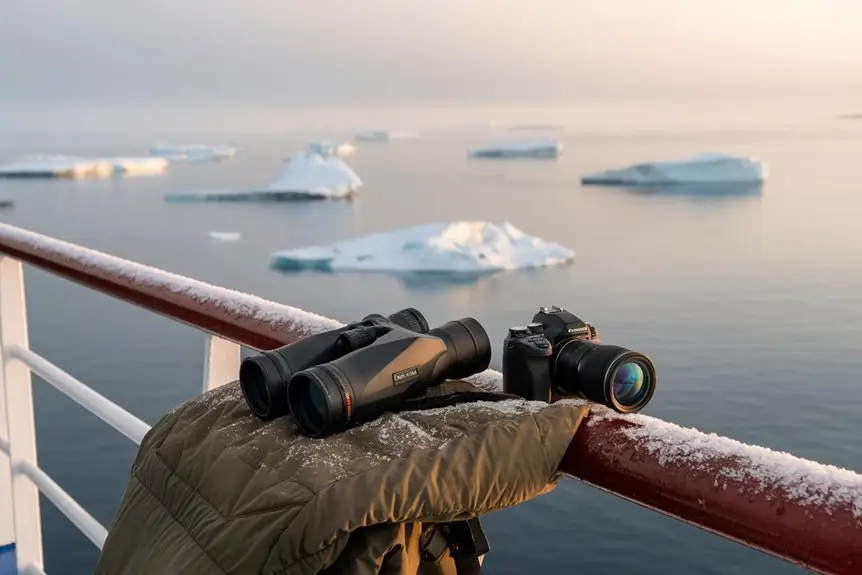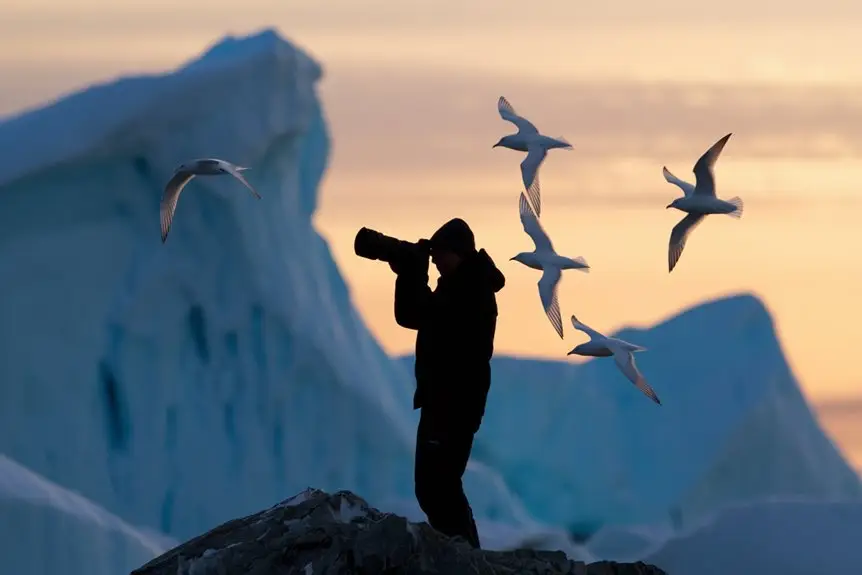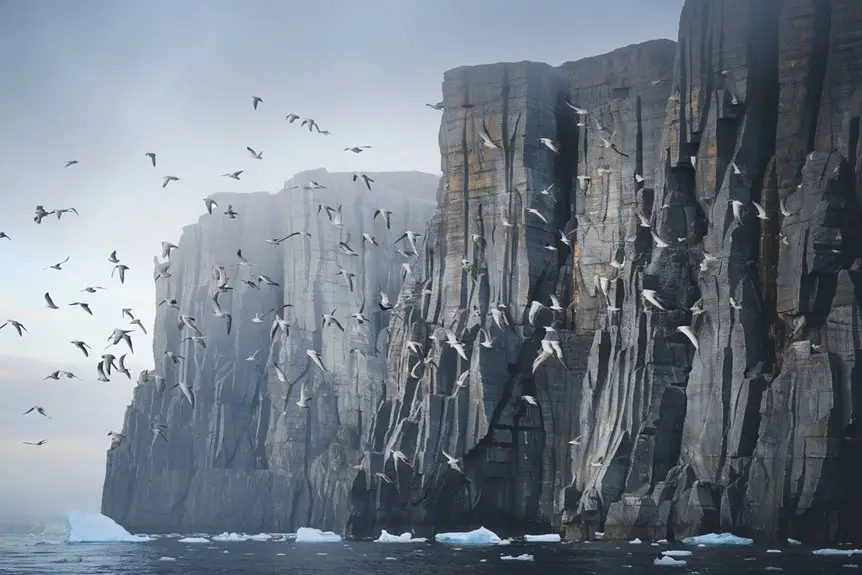Planning your polar seabird adventure is straightforward with the right timing and gear. You need to visit Antarctica between mid-December and mid-February, or the Arctic from June to August. Take binoculars with 8x or 10x magnification for clear views. Pack spare camera batteries, as the cold will drain them faster than usual.
For other Wildlife Spotting in Polar Regions check out our Wildlife Spotting in Polar Regions Guide page.
You’ll spot the most birds at these prime locations:
- Antarctic Peninsula
- South Georgia
- Ross Sea
These sites let you watch albatrosses, petrels and penguins in their natural habitat. You need to set your camera with fast shutter speeds and correct white balance for sharp photos. Keep a safe distance from all birds to protect both them and yourself.
🐧 Polar Cruise Enquiry 🐻❄️
Our team of polar travel specialists have personally explored both the Arctic and Antarctic regions – from tracking polar bears in Svalbard to kayaking with penguins off the Antarctic Peninsula. Let us find the right polar expedition cruise for you.
Key Takeaways
When to Go
You’ll find the best seabird viewing from mid-December to mid-February in Antarctica, and June to August in the Arctic.
Essential Equipment
You need:
- Waterproof binoculars
- Telephoto camera lens
- Extra camera batteries (cold weather drains them quickly)
Photography Tips
You should:
- Use a fast shutter speed (1/800th second)
- Keep a safe distance from birds
- Frame shots carefully for natural behaviour
Top Locations
Visit these prime spotting areas:
- Antarctic Peninsula
- South Georgia
- Ross Sea
Bird Identification
You can spot different species by:
- Wing shapes
- Bill types
- Flight patterns
Keep a field guide handy to match your sightings with known species.
When to Go Seabird Spotting

Best Times for Seabird Watching
You’ll find different seabird viewing seasons between Earth’s polar regions.
Antarctica (Southern Hemisphere):
- Visit from mid-December to mid-February to see active penguins and their chicks.
- Choose November or early December for breeding season and clear landscapes.
- Watch penguin chicks in late January.
Arctic (Northern Hemisphere):
- Plan your trip from June to August for prime viewing.
- You’ll benefit from long daylight hours.
- You can spot arctic terns, petrels and fulmars on cliffs and tundra.
- Watch migration patterns in August and September.
Species-Specific Timing:
- Penguin chicks: Late January.
- Arctic terns: June to August during migration.
- Breeding colonies: Early summer in both regions.
This timetable helps you match your visit with peak seabird activity in both polar regions.
You’ll maximise your chances of seeing your preferred species by following these seasonal guidelines.
Best Spotting Locations

Best Places to Spot Antarctic Seabirds:
You can find Antarctic Petrels along the Ross Sea coast, with Snow Petrels gathering near the Ross Ice Shelf’s icebergs.
Watch South Polar Skuas at penguin colonies across the Antarctic Peninsula.
South Georgia offers you excellent views of three albatross types:
- Wandering albatross
- Grey-headed albatross
- Black-browed albatross
You’ll spot Blue-eyed Shags on rocky cliffs and in shallow waters around the Antarctic Peninsula.
The Falkland Islands give you chances to see striated caracaras and several penguin species.
Your best viewing options:
- Antarctic Peninsula cruises
- South Georgia voyages
- Ross Sea expeditions
These routes let you see the widest variety of seabirds in their natural habitats.
Essential Equipment For Success

Essential Equipment for Your Antarctic Birdwatching
You need specific tools to spot Antarctic seabirds effectively during your polar trip. Your most important item is a pair of quality binoculars with fog-proof and weatherproof features.
Premium brands:
- Swarovski
- Zeiss
- Leica
Budget-friendly choice:
– Nikon Prostaff 3S
Choose your magnification:
- 8x for wider views
- 10x for closer detail
Your essential accessories include:
- Lens cloths for salt spray cleaning
- Waterproof bags for gear protection
- Extra batteries for all devices
- 300mm+ telephoto lens for photography
- Spotting scope with tripod for distant viewing
Remember: The Antarctic cold will drain your batteries quickly, so pack more than you think you’ll need.
See what’s on offer from the Marine Life on a Polar Cruise Guide for a different Wildlife Spotting in Polar Regions.
Wildlife Photography Tips

Quick tips for taking wildlife photos in Antarctica
You need these camera settings:
- Set your shutter speed to 1/800th second to capture clear bird movements
- Keep your ISO as low as possible for crisp photos
- Adjust your white balance to handle the bright polar light
- Use RAW format to edit high-contrast scenes later
You can improve your composition by:
- Using the rule of thirds to place your subjects
- Creating space around your wildlife subjects
- Getting down to the same level as birds for better angles
You must follow these practical steps:
- Protect your camera from extreme weather
- Store spare batteries close to your body for warmth
- Stay at a safe distance from all wildlife
These straightforward techniques will help you capture memorable Antarctic wildlife photos.
Each adjustment makes a real difference to your final images. Your photos will show the true beauty of these polar creatures whilst keeping them safe and undisturbed.
Seabird Species Identification Guide

Want to identify seabirds in Antarctic waters? Let’s break down the key features of common species.
Albatrosses stand out with two main traits:
- Long, narrow wings
- Distinctive tube-shaped bills
You can spot two types:
- Great albatrosses: white bodies with black wing tops
- Mollymawks: smaller size with varied colours
To tell petrels and shearwaters apart from gulls:
- Look for their tube-shaped bills
- Watch their distinctive flight patterns
- Notice their narrower wings compared to gulls
Storm petrels are easy to recognise by:
- Their tiny size
- White rump patches
- Filter-feeding behaviour at sea
You’ll need to watch for:
- Overall shape and movement (jizz)
- Seasonal plumage changes
- Age-related colour variations
Keep a trusted guide like Harrison’s “Seabirds” with you for detailed reference, as many species share similar features.
Frequently Asked Questions
Can Seasickness Affect My Ability to Spot Seabirds From the Ship?
Seasickness can definitely affect your seabird watching experience aboard ships. Your spotting ability drops when you’re feeling queasy, as your brain struggles to focus on distant birds. You might find it hard to hold binoculars steady or keep your eyes on the horizon. To enjoy your birdwatching, take anti-seasickness tablets before sailing and stay in the middle of the ship where movement is less noticeable. If you start feeling unwell, take a break from watching and get some fresh air on deck.
Are There Age Restrictions for Zodiac Excursions to View Seabirds?
You need to be at least 12 years old to join zodiac seabird excursions. Your child might join at a younger age with special approval from the tour operator. You must be able to step into moving boats and walk steadily on uneven surfaces. There’s no maximum age limit, as long as you meet these physical requirements.
How Close Can Cruise Ships Legally Approach Seabird Nesting Colonies?
Cruise ships must stay 300-500 metres away from seabird nesting colonies. You can still observe the birds clearly from this safe distance. Your ship’s crew follows local regulations to protect the nesting sites. These distances help minimise stress on the birds whilst allowing you to enjoy watching their natural behaviours.
Do Seabirds Follow Specific Ships More Than Others During Antarctic Voyages?
Seabirds will follow specific ships during Antarctic voyages, and you’ll spot them most often around two main vessel types:
- Large, slow-moving ships:
- Research vessels
- Expedition cruise ships
- Ships with food opportunities:
- Fishing boats
- Vessels with open deck spaces
These birds choose their target ships based on speed and food availability. You’ll see them circling and trailing behind these vessels, looking for easy meals from either fishing activities or passenger food waste.
What Happens if Severe Weather Prevents Scheduled Seabird Spotting Activities?
When severe weather disrupts your seabird spotting plans, you can participate in several indoor activities:
You can join expert talks about seabirds and their behaviour. You’ll learn about migration patterns, feeding habits and identification methods from experienced guides.
You can study field guides and reference materials to improve your bird recognition skills. You’ll become familiar with key features that help you identify different species quickly.
You can use this time to check weather forecasts and plan your next observation session. This helps you choose the best times to resume your deck watches when conditions improve.
Your safety comes first, and these alternatives keep you engaged with seabird watching until you can return to the deck.
Thinking about something different? Check out the Under-Ice Wildlife on Polar Cruises.
🐧 Polar Cruise Enquiry 🐻❄️
Our team of polar travel specialists have personally explored both the Arctic and Antarctic regions – from tracking polar bears in Svalbard to kayaking with penguins off the Antarctic Peninsula. Let us find the right polar expedition cruise for you.
